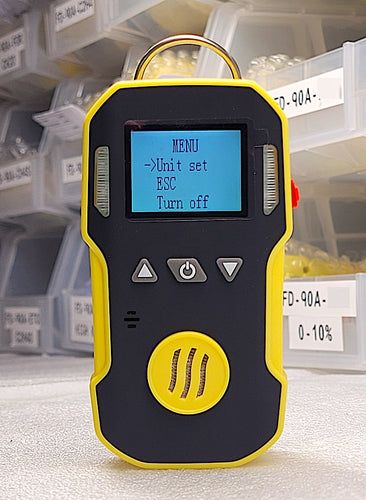An ethylene oxide (ETO) gas detector, also known as an ETO detector or ETO gas leak detector, is a critical safety device that accurately senses and measures the concentration of ethylene oxide gas in the air. These detectors are primarily used for personal protection in hazardous gas environments where exposure to ETO may occur. In healthcare settings, ETO gas leak detectors play a crucial role in safeguarding the well-being of medical staff during the sterilization of medical instruments. By continuously monitoring the air and providing real-time ETO concentration measurements, these gas detectors help ensure the safety of healthcare workers and prevent potential health risks associated with ethylene oxide exposure.
Pros |
Cons |
|
✅ Small and low cost ETO gas detectors helps with worker safety. ✅ ETO gas detectors are available for less than $399. ✅ Wall-mounted ETO systems are also used to alarm when there is a ETO gas leak. |
⛔ ETO sensors typically last from 24 to 36 months. ⛔ Health care workers are exposed to ethylene oxide in hospitals or when sterilizing. ⛔ ETO gas is increasingly being used for sterilization, and hence, poses more of a risk to workers. |
What Is the Best Ethylene Oxide Detector?
There are many ethylene oxide detectors on the market. The top reputable brands include the following:
- Forensics Detectors Ethylene Oxide Detector
- RC Systems Ethylene Oxide Detector
- Draeger ETO Detector
- Evicon ETO Gas Detectors
- Honeywell ETO Gas Detector
How Do I Select an Ethylene Oxide Detector?
To select the best ethylene oxide detector, follow this simple guide:
- What do I need it for?
- Personal Protection?
- Gas Leak Detection?
- Continuous Room Monitoring?
- What is my budget and operating cost budget?
- Do I need advanced functions such as data-logging or Bluetooth?
- Do I need specific accreditations with the monitor such as ATEX or a NIST traceability calibration certificate?
- Do I require a belt clip for attaching the device to my clothes?
- Do I need after-sales support, USA headquarters, or fast calibration services?
What Is an Ethylene Oxide Detector?
An ethylene oxide (ETO) gas detector is an instrument used to detect the concentration of ethylene oxide in the air.
These devices (specifically the Forensics Detectors FD-90-ETO) have a long-life battery, large screen that displays the ETO concentration, and a belt clip to connect to clothing. In order to protect users, these gas detectors also have LED, vibration, and buzzer alarms.
Ethylene oxide gas detectors are also known as ETO monitors, eto gas leak detector, ethylene oxide sniffers, ethylene oxide analyzers, and ethylene oxide gas testers. These names all refer to the same device, an ethylene oxide gas detector.
What Does an Ethylene Oxide Meter Detect?
A ethylene oxide detector senses ethylene oxide (ETO) gas in air and displays the gas concentration in the parts per million concentration scale, which is abbreviated as ppm.
What Is Ethylene Oxide Gas?
Ethylene oxide has the chemical symbol C2H4O. It is a very useful yet dangerous gas, hence the need to monitor and check air concentrations particularly in the presence of humans.
Is Ethylene Oxide Toxic?
Yes it is.
- Acute ETO exposure you may result in respiratory irritation, lung injury, nausea, vomiting, and headaches. Symptoms from hospital workers are presented here.
- The EPA categorizes ETO as a carcinogen. Some example cases linking ETO to cancer incidents are prevalent.
- Long term and chronic exposure studies have shown possible neurotoxicity.
Can I Smell Ethylene Oxide Gas?
Yes, humans can smell ethylene oxide gas.
It has been described as a sweet smell. Others have described it as "pleasantly to sickeningly sweet, fruity, alcoholic, or acetone- or ether like."
The ethylene oxide odor threshold is between 260 ppm and 700 ppm. See here.
However, it is a bad idea to rely on your sense of smell to determine the "concentration" of an aromatic gas like ETO. Over time, the nose becomes desensitized to the odor - this phenomena is called olfactory fatigue.
What Are the Different Types of Ethylene Oxide Detectors?
Type |
Description |
Ethylene Oxide Gas Leak Detector
|
These are handheld combustible gas leak detectors used to check for ethylene oxide leaks in sterilizers. ETO is a combustible and can be monitored using a combustible gas leak detector. These units are excellent for spot and point checking as long as the ETO concentration is high it will pick it up, if it is too low (i.e. less than 50 ppm), it will not.
 |
|
Ethylene Oxide Detector for Personal Protection |
The majority of ethylene oxide gas detectors are portable. These are small, battery-powered units with an ethylene oxide sensor that can be clipped onto your clothes for personal protection. The units are the most popular for personal exposure safety PPE and indoor air quality ETO detection.  |
| Ethylene Oxide Monitor for Stationary Fixed Wall |
Wall-mounted units provide continuous protection and warning of ethylene oxide gas leaks. These devices are perfect for continuous indoor monitoring, such as a hospital room used to sterilize instruments with ETO. If the levels pass the preset threshold (i.e., 1 ppm OSHA TWA), the unit will provide an LED and buzzer warning.  |
How Does an Ethylene Oxide Gas Sensor Work?
An ethylene oxide gas detector is composed of electronics and an ETO sensor elemt. The gas sensor converts the detected gas concentration to an electronic signal for analysis by an onboard microprocessor. After receiving the electrical signal, the processor displays the ETO concentration reading. If the measurement exceeds the pre-set ETO alarm value, the alarms are triggered.
Gas |
Sensor Technology |
Pros |
Cons |
|
Ethylene Oxide (ETO) |
Electrochemical Sensors The gas reacts with a working electrode, triggering an electrochemical redox reaction. The generated current is proportional to the detected gas level. |
|
|
What Are Safe Ethylene Oxide Gas Levels?
Various government agencies have recommended gas exposure limits, examples can be seen below:
Agency |
Recommendation / Requirement |
|
National Institute for Occupational Safety and Health (NIOSH) |
NIOSH Recommended Exposure Limit (REL): 0.1 ppm, 10-hour TWA 5 ppm, 10-minute ceiling |
|
Occupational Safety and Health (OSHA) |
1 ppm average over 8 hours 5 ppm average over 15 minutes (Permissible Exposure Limit) |
|
American Conference of Governmental Industrial Hygienists (ACGIH) |
1 ppm average over 8 hours |
What Is an Ethylene Oxide Detector Used For?
Ethylene oxide gas is used in a variety of manufacturing and industrial processes, examples are listed below. It is primarily used in hospitals to sterilize medical instruments. Because ETO is toxic, it is important to monitor for employee safety.
- ETO for medical sterilization (hospitals): Ethylene oxide is used to chemically sterilize heat-sensitive materials in hospital settings. Health care workers can be exposed to high levels of ETO when sterilizing, leading to toxic gas exposure. One study showed ethylene oxide breathing zone levels of up to 250 ppm.
- ETO for fumigation agriculture: ETO is used to fumigate grain bins and wheat sacks. Others agricultural items include food, commodities such as tobacco, and grains.
- ETO for industrial uses: Ethylene oxide is heavily used in industry to make polyester and other products such as ethylene glycol (antifreeze).

How Long Does an Ethylene Oxide Sensor Last For?
Ethylene oxide detectors incorporate small electrochemical sensors that usually last between 2 to 3 years.
How Do I Test My Ethylene Oxide Detector?
The best way to test your ethylene oxide gas detector is to expose it to a known gas source. Generally referred to as bump testing, this is a good practice to perform daily. Frequent testing is especially important in personal protection applications where safety is paramount - more about bump testing in the next section.
What Is an Ethylene Oxide Detector Bump Test?
Bump testing is a procedure where the user exposes the detector to a small amount of “blast” target gas to ensure the detector operates and alarms as programmed. Ethylene oxide bump test gas can be found here.
What Is Ethylene Oxide Detector Gas Calibration?
Ethylene oxide gas detector calibration is the technical task of adjusting the detector to a more accurate gas reading. Over time, the sensors on the device will degrade or produce drifting readings. We suggest calibrating your ETO detector every 6 to 12 months, the typical time period for gas detectors.
Gas calibration is a technical task that requires certain key pieces of equipment. These include a calibration gas bottle, gas regulator, tubing, and calibration cap fitting. You need to communicate with the manufacturer to determine the recommended calibration gas concentrations and mixtures. For the Forensics Detectors ETO gas monitors, we recommend the calibration gas here.
Be attentive and calibrate daily if:
- The user employs the device as an analytical tool where accuracy is paramount.
- The device is used in an extreme environment (temp and humidity extremes create sensor drift).
- The user is performing an imminently dangerous application.
- Bump testing fails. In this case, you must calibrate to make sure the sensors and monitor operate properly.
- The ETO gas detector alarms in the fresh air. This could mean that the sensor has drifted past an alarm set-point.
Calibration and bump testing are mandatory because injury or death can occur if the device fails. Take it very seriously.
Also, it is prudent to have a calibration schedule that the owner or employees strictly follow. See gas calibration here.
Is Ethylene Oxide Gas Explosive?
Yes it is.
Ethylene oxide is flammable at concentrations above 2.7% in air.
Therefore, ETO gas has a lower explosive limit (LEL) of 2.7% - this means it is too lean to burn.
The upper explosive limit (UEL) of ETO is 100%.
Can You Smell Ethylene Oxide?
Ethylene Oxide has a mildly sweet, ether-like odor detectable at 260-700 ppm. However, these levels are well above those considered immediately dangerous to life and health.
Final Words
Ethylene oxide (ETO) is a crucial component in modern healthcare, playing a vital role in the sterilization of medical instruments and equipment. However, the use of this toxic gas also presents significant health risks to hospital staff. ETO gas detectors are essential for personal protection in hazardous gas environments, particularly during sterilization processes. These detectors continuously monitor the air, providing real-time measurements of ethylene oxide concentrations and alerting users when levels exceed safe thresholds. Additionally, ETO gas leak detectors are indispensable tools for identifying and addressing leaks from sterilizers, helping to prevent potential health risks to healthcare workers. With ETO gas detectors being affordable, costing less than $400 per unit, hospitals and healthcare facilities should prioritize the safety of their staff by investing in these life-saving devices. Proper use and maintenance of ETO gas detectors, along with comprehensive safety training, are crucial for maintaining a safe working environment and protecting the well-being of healthcare professionals who work with ethylene oxide sterilization equipment.
About The AuthorDr. Kos Galatsis ("Dr.Koz") is the President of FORENSICS DETECTORS, where the company operates from the scenic Palos Verdes Peninsula in Los Angeles, California. He is a subject matter expert on gas sensor technology, gas detectors, gas meters, and gas analyzers. He has been designing, building, manufacturing, and testing toxic gas detection systems for over 20 years. 
Every day is a blessing for Dr. Koz. He loves to help customers solve their unique problems. Dr. Koz also loves spending time with his wife and his three children going to the beach, grilling burgers, and enjoying the outdoors. Read more about Forensics Detectors here. Email: drkoz@forensicsdetectors.com
|

